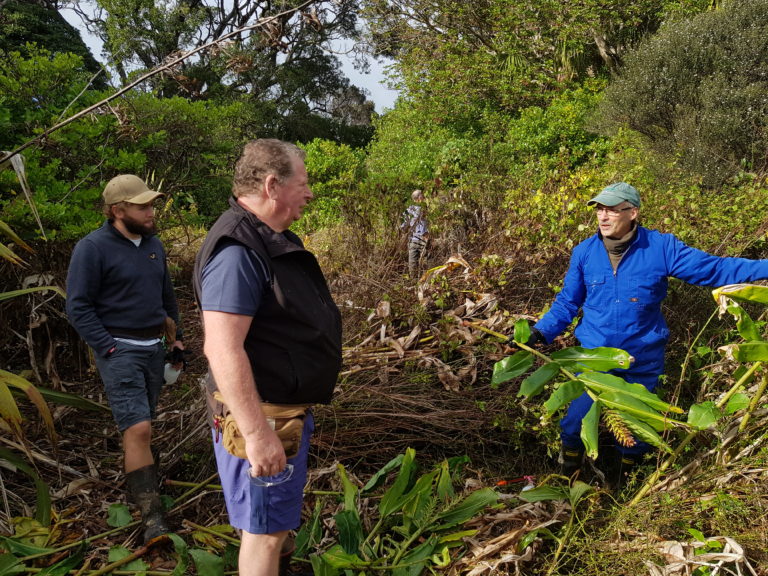 Solanum mauritianum
Solanum mauritianum
Just want to know how to kill it?
Skip to control methods
Also known as
Tobacco weed, kerosene plant, flannel-leaf, Solanum auriculatum
This ugly, itchy invader made our Dirty Dozen list because it is spreading rapidly around the Whangarei Heads peninsula, and left to its own devices, over time it will take over the road edges, shrublands, forest margins, forest gaps, forestry and coastal areas. Both visually and ecologically it is not something we want out at the heads. It is also easy to identify and control, so we can make a difference if the community works together to tackle it.
What does it look like?
A kerosene/capsicum-smelling shrub or small tree, growing up to 10m tall, with whitish, branching soft-woody stems. All parts covered in dense felt-like hairs. The large velvety, oval leaves (10-35 x 3-15 cm), are grey-green on the upper surface, and white to yellowish underneath with prominent ‘ears’ (25mm) at base which clasp the stem. Produces dense clusters of mauve to purple flowers (15-20 mm diameter) with yellow anthers, followed by clusters of round berries (1 cm diameter) that ripen from hard green to soft, dull yellow.
and whitish, branching, soft-woody stems.
Why is it a problem?
Forms dense, often pure stands, crowding out other plants, and inhibiting or preventing the establishment of native plant seedlings (it is allelopathic – meaning they produce toxins that poison the soil).
It grows and matures rapidly, producing many well-dispersed seeds most of year. Berries are toxic and the hairs/dust from the plant irritates skin, eyes, nose, throat. It tolerates wet to dry conditions, salt, all well-drained soils, hot to cool temperatures, semi-shade, damage and grazing.
It will invade heavily disturbed forest and light gaps, shrublands, coastal and estuarine margins, and wetlands.
How much of it do we have on the Whangarei Heads Peninsula?
This weed is spreading fast. Long time residents know there was none here at all until the 1980s, when seeds came in on machinery at Manganese point, and from there it has now spread all over the Heads, and its rate of increase is increasingly rapid (weed invasion starts slow and then becomes exponential). However, it is still not YET a dominant species in most of our natural areas, and by taking action stopping the spread we can make a huge difference.
How does it spread?
Birds, especially native pigeon, eat the large fruits and spread the seeds. It often grows and spreads along roadsides and disturbed areas.
What can we DO about it?
Lots! Woolly nightshade grows and matures very quickly but it quite easy to kill. By tackling the outlying individuals we can greatly reduce the rate of spread and the amount of seed entering the local environment. Keeping forests healthy and intact also reduces the spread as woolly nightshade invades more open and disturbed habitats. There is also a biocontrol agent in development.
Check out the control methods below:
How do I control it?
Additional safety note: Wear a mask and gloves when undertaking woolly nightshade control for a prolonged period as the leaves shed fine hairs when touched which can irritate skin, eyes, nose and throat. The berries are toxic and handling the plant can cause nausea in some people. Stock may also be at risk.
- Hand control: Pull out seedlings and small plants. Leave to rot on site
- Cut stump application: Cut within 2 cm of ground level and immediately treat stump with Trichloram at 200mls/L water or Weed Action’s Gly/ Met Mix. Cut stems can be left on site to rot down. .
- Drill & fill: Drill using 12-13mm auger bit sloping holes into the sapwood at 10 cm intervals around the base of the trunk and any exposed roots. & immediately fill each hole with Weed Action’s Gly/ Met Mix or trichloram at 200mls/ L water.
- Frill and Fill: Make deep downward cuts into the sapwood around the base of the tree, taking care not to ring bark the plant, and immediately saturate the cuts with trichloram at 200mls/ L water.
- Spray seedlings with trichloram at 6mls/L of water + penetrant, best in spring and summer.
Does not tolerate shade well. Maintain shade by planting dense cover, protecting habitat integrity. Kill standing where possible to allow easy access for seedling follow up. Follow up for 3 years
CAUTION: when using any herbicide or pesticide PLEASE READ THE LABEL THOROUGHLY to ensure that all instructions and safety requirements are followed.
Click here for more information on the herbicides referenced in the control methods, or here for more information on the suggested techniques.
Save



